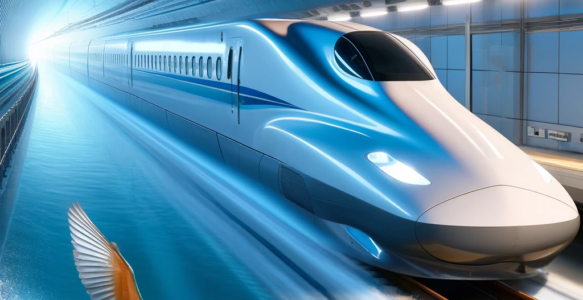In the world of high-speed trains, Japan’s Shinkansen, often referred to as the “Bullet Train,” stands out for its speed, efficiency and for its unique design inspired by the natural world. This iconic train is a prime example of biomimicry, where engineers turn to nature to solve complex human challenges. One of the most fascinating aspects of the Shinkansen’s design is how it was inspired by the kingfisher, a bird known for its high-speed diving and ability to enter water with minimal splash.
The Challenge of Speed and Sound
As the Shinkansen trains began to reach higher speeds, they faced a significant engineering challenge: noise. Particularly, the loud noise produced when the trains emerged from tunnels, known as “Sonic Booms,” became a problem. This noise occurred because the train, moving at high speed, would push air in front of it as it entered a tunnel, compressing it rapidly and creating a shockwave that would then exit the tunnel with a loud boom.


Inspiration from Nature: The Kingfisher
The breakthrough came from the kingfisher. Engineers noticed that the kingfisher, when diving into water to catch prey, produced very little splash. The bird’s ability to move from one medium (air) to another (water) so smoothly was due to the shape of its beak, which is long, narrow, and highly streamlined.
Observing this, Eiji Nakatsu, the engineer and birdwatcher, saw an opportunity to apply this natural solution to the Shinkansen’s problem. The front car of the trains was redesigned to mimic the kingfisher’s beak. The new design was more aerodynamic and allowed the train to enter and exit tunnels with significantly reduced air pressure changes, thus minimising the Sonic Boom effect.
The Results: Faster and Quieter
The redesign was successful in reducing noise and brought additional benefits. The new, more aerodynamic nose of the Shinkansen allowed it to consume less power while maintaining high speeds. Moreover, it also reduced the environmental impact by decreasing energy consumption. The trains were able to operate faster and more quietly, enhancing the comfort of passengers and reducing noise pollution in the surrounding environment.
Beyond the Design: Continuous Improvement
The story of the Shinkansen and the kingfisher is a testament to the power of biomimicry in engineering. It demonstrates how solutions to some of our most complex technological challenges can come from simple observations of nature. Today, the Shinkansen continues to evolve, incorporating lessons from the natural world and the latest advancements in technology to ensure safety, efficiency, and sustainability.
The influence of the kingfisher-inspired design goes beyond just the railways. It serves as a powerful example of how observing nature can lead to innovative solutions that improve the functionality and efficiency of our technology. This successful combination of biology and engineering resolved practical issues and set the stage for future innovations across various industries. As we continue to face new challenges, the story of the Shinkansen and the kingfisher encourages us to explore nature’s ingenuity for solutions, showing us that often, the answers we are searching for are already present in the natural environment around us.


